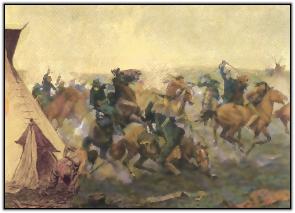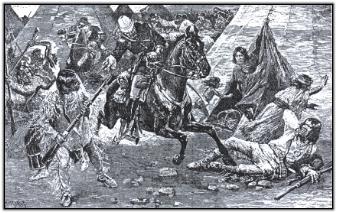| For an elite outfit, the 7th Cavalry made
a falting start on Sheridan's winter war. Custer's Indian scouts got lost
in a snowstorm. But the blond long-haired colonel soon straightened them
out with compass bearings. After a punishing three-day march over snow covered,
frozen country, Custer slowed his advance and sent his second-in-command
ahead on a scout, or reconnaissance. Major Joel H.Elliott's squadron found
tracks of a large number of Indians - automatically war party in Custer's
eyes. Guided by an Osage scout, Custer cought up with Elliott and reconnoitred
Black Kettle's camp near today's Cheyenne, Oklahoma. Black Kettle, on his arrival home, had called a council to give his people assurances from Fort Wallace that they would never ba attacked. The chief awoke just before dawn the next morning, 27 November 1868, to hear a woman crying, 'Soldiers! Soldiers!' Sand Creek must have flashed through the chief's mind as grabbed his rifle and fired a warning shot. Black Kettle waited at the ford, hoping to stop the soldiers and talk peace. But they enveloped the village from four directions. So, under the fluttering Stars and Stripes and white flag of peace, Black Kettle got on his horse and took his wife (wounded at Sand Creek) up behind him. They were among the first to fall in a hail of bullets. It took Custer barely ten minutes to secure the village. The 'Battle of the Washita' has been called a massacre and it was not a clear victory for Custer. The Washita campaign 'made' Custer, despite comparisons with Sand Creek. He said to have counted 103 dead Cheyennes on the field. But there were whispers that only a dozen or so were really warriors. (9) |
|
 "Attack at Dawn" by Charles Schreyvogel |
 A contemporary picture of the event, from: "Harper's Weekly" |